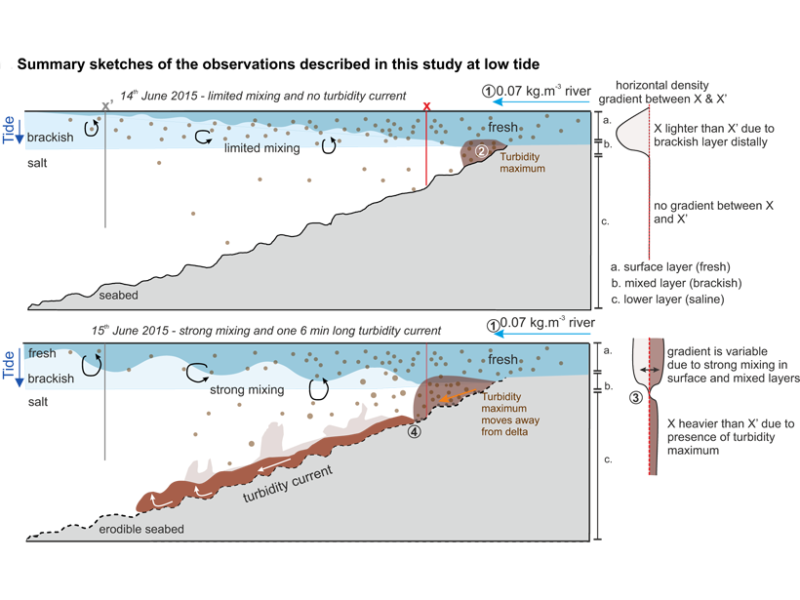Submarine Rivers of Sediment
Turbidity currents move suspended sediment into the ocean. In general, the more sediment, the stronger the turbidity current, but one process may generate turbidity currents from very dilute rivers.
SOURCE: Geophysical Research Letters

Observations at the study site on consecutive days. The lower panel shows the mechanism of generating a turbidity current from a dilute plume. Turbidity maximum induced on the upper part of the slope generates weak downslope motion, which is amplified by erosion and produces a strong turbidity current. Credit: Hage et al. [2019], Figure 6a, top two panels
Marine turbidity currents can be generated by submarine landslides or by sediment load from rivers, both of which act to increase the density of water. This high-density water then propagates along the sea floor, powered by its own density anomaly.
The standard theory for river-induced turbidity currents is that a large sediment input from the river is required. Hage et al. [2019] turn that theory on its head. They demonstrate that turbidity currents can, in fact, be generated from rivers with a very small sediment load. The case is made with an incredibly detailed set of measurements which catch a short (6 minute) turbidity current in the act of forming and dissipating – even showing the change in sea floor bathymetry after the event. These results will lead to a re-evaluation of how and when turbidity currents form.
Citation: Hage, S., Cartigny, M. J. B., Sumner, E. J., Clare, M. A., Hughes Clarke, J. E., Talling, P. J., et al [2019]. Direct Monitoring Reveals Initiation of Turbidity Currents From Extremely Dilute River Plumes. Geophysical Research Letters, 46. https://doi.org/10.1029/2019GL084526
—Andrew M. Hogg, Editor, Geophysical Research Letters
AGU发布最新国外工作学习机会:
1.Postdoctoral Research Scientist in Theoretical/Computational Space Plasma Physics
Los Angeles, California
Space Science Institute
The Space Science Institute (SSI) invites applications for a Postdoctoral Research Scientist to be based in Los Angeles, CA. The selected candidate will take a leading role in research on ultra low frequency (ULF) waves and associated ion distributions in the Earth's ion foreshock.
2.Postdoctoral Fellow (River Corridor Modeler)
Berkeley, California
Lawrence Berkeley National Laboratory
Berkeley Lab's Earth and Environmental Sciences Area has an opening for a Postdoctoral Fellow.
https://findajob.agu.org/job/8011583/postdoctoral-fellow-river-corridor-modeler-/
3.Postdoctoral Position in Planetary and Exoplanetary Atmospheres Modeling
Pasadena, California (US)
Jet Propulsion Laboratory/NASA
The Astrophysics and Space Science section of the Jet Propulsion Laboratory (JPL) invites applications for one postdoctoral position to collaborate with Dr. Renyu Hu on exoplanetary atmospheres modeling.
4.Ph.D. Opportunity in Grassland Dynamics and Extreme Climate Events-disturbance Interactions
University of South Dakota
5.Ph.D. Position in Ocean Acidification
Corpus Christi, Texas
$2000 monthly stipend with tuition support
Texas A&M University - Corpus Christi
https://findajob.agu.org/job/8011567/ph-d-position-in-ocean-acidification/



